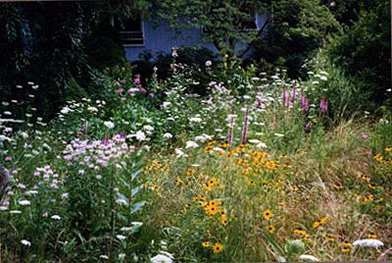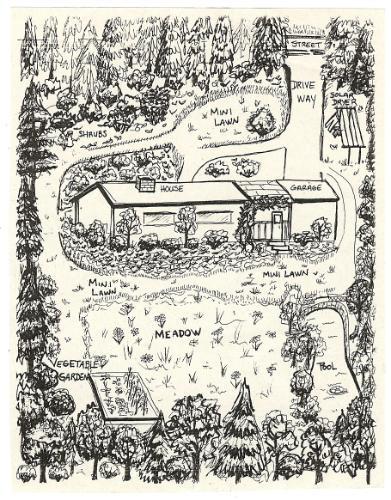by William A. Niering (1924 - 1999)
How SALT (Smaller American Lawns Today) began
It all began in the early 1970's on a one-acre lot while using one of the noisiest polluting power mowers available and undoubtedly disturbing my neighbor's summer party across the street. "How can I develop a more environmentally friendly home ground with only a small lawn and minimum care?" I pondered. Here is what I did, and I'd like to share with you my experience in decreasing the size of my lawn.
My first step was to create tree/shrub plantings along the property lines.
This was not a gesture of unfriendliness to my neighbors, as we are all friends. Rather it was to create greater privacy and decrease lawn area. In my case, it also included a screen along the road in front of the house. What does one plant, and where do you get the plant material, which can be costly? Fortunately, it can often be salvaged, in part, from vacant lots which are going to be developed or from friends who have extra trees and shrubs. For example, I salvaged red cedars, hemlock, flowering dogwood, and high bush blueberries. I used a mixture of both evergreen and deciduous native and introduced trees and shrubs. Try to avoid single species plantings. My one exception was an arbor vitae tree border which makes an excellent narrow screen where width is limited. Your undulating border plants will begin to define and enclose your property and reduce lawn.
Next, you will need to start on your foundation plantings. They can be expanded in width and include ground covers, perennial flower beds, and your favorite shrub plantings. I have extensive areas of evergreen ground covers (English ivy, periwinkle, and pachysandra) covering areas that were formerly lawn.

Now let us consider the possibility of a vegetable garden and a natural meadow in part of the back lawn. Choose the sunniest place for the vegetable garden. Tomatoes, beans, peas, squash, and even corn can be included. As few as four hills of corn can cross pollinate and be productive. If raccoons become a problem, chicken fencing is usually effective from my experience. The meadow can take as much of your remaining lawn as you want. There are some people who prefer no lawn, which is ideal! To create the meadow, just stop regular mowing. I was amazed the first year when I had lots of yellow daisy-like hawk weeds flowering, and in the fall lovely reddish-tan clumps of little blue stem appeared. These grasses are showy throughout the fall and especially striking in the winter snow. It was a new and exciting experience and one which has continued for more than two decades. I have watched new plants appear and added those I especially like. If a tree or unwanted shrub seedling appears, like black cherry, oak or ash, etc., I immediately pull or dig it out roots and all. As the grasses and other plants become more dense, fewer woody plants appear. I created a more or less self-perpetuating meadow that only needs to be mowed once or twice a year. Today, after more than 25 years, the meadow is more beautiful than ever. I have added clumps of the native bergamot, a beautiful lavender mint, purple blazing star, black-eyed Susans, ox-eye daisies, and Queen Anne's lace. By mid-July, the meadow is ablaze with color and filled with insects, especially bees, busy with their job of pollination. In the fall and winter, we still enjoy the late maturing clumps of little blue stem grass.
Ecologically, why is the movement toward naturalistic landscaping important? There are several reasons. With minimum lawn one may abandon the power mower for a reel mower and conserve fossil fuel and prevent air pollution. Commercial fertilizers and lawn pesticides can also be abandoned, and you will have more time to do other things. In addition, you are undertaking a kind of ecological landscape restoration--favoring old fields or meadow habitat, one of the most endangered in the Northeast. You are also increasing bio-diversity--creating habitat for many kinds of other life forms which are becoming increasingly endangered by human activities. By decreasing the size of your lawn with the addition of tree, shrub and meadow habitat, you share your home grounds with a myriad of wildlife, which can also be an added pleasure. Throughout the years, as the diversity of our property has increased, we have found increasing numbers of birds including hummingbirds, rose-breasted grosbeak, towhee and wood thrush, as well as butterflies and beautiful insects.
In an industrial world where natural landscapes are constantly disappearing, you have an opportunity to reverse the trend toward homogeneity or monoculture by creating on your home grounds elements of the natural world that can blend into those natural areas that still exist as self-perpetuating solar, not fossil fuel, subsidized systems. Your naturalistic landscaping will also contribute toward countering climatic warming in the 21st century. Put your lawn mower in moth balls, get a cold drink, and really enjoy your home grounds.
